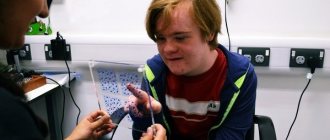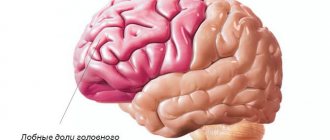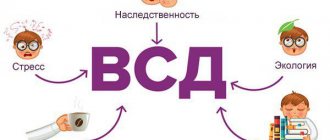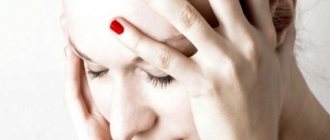Causes
Psychovegetative disorders are often diagnosed in children of the older age group, as well as in adolescents and young adults. In more rare cases, the disease appears in people over 40 years of age. Neurocirculatory dystonia most often develops in young people. This is primarily due to the slow development of the neuroendocrine system in a young body, as well as the inconsistency between physical development and the functioning of the endocrine system.
Psychovegetative syndrome manifests itself under the influence of hereditary factors, constitutional characteristics, damage to the nervous system of an organic nature, somatic and mental disorders. Symptoms of the disease also appear due to hormonal changes in the body, psychophysiological changes (we are talking about stress - acute and chronic), psychosomatic diseases (heart disease, hypertension, bronchial asthma, etc.), diseases of the nervous system, some occupational diseases, mental disorders and neuroses .
All the described factors contribute to the manifestation of vegetative dystonia. If the disease is not treated in a timely manner, it may be complicated by the manifestation of panic attacks .
Autonomic dysfunction often occurs as a consequence of organic diseases of the brain, as well as in the presence of damage to the peripheral nervous system . But one of the most common causes of autonomic disorders is the process of endocrine changes in the human body during adolescence, as well as in women during menopause. A separate form is psychophysiological vegetative dystonia, which manifests itself in humans as a consequence of stress, severe physical strain, overwork , and neurotic disorders.
Clinical signs
An important feature of the psychovegetative syndrome is the multiplicity of autonomic disorders. In this case, patients indicate the following disorders:
- feeling of tightness in the chest, changes in heartbeat;
- stomach ache;
- frequent vomiting;
- headache;
- dizziness;
- neuralgia of various localizations;
- problems with urination;
- increased sweating;
- changes in the menstrual cycle;
- feeling of cold.
Typically, psychovegetative syndrome with anxiety manifestations is characterized by the following symptoms:
- tension in the body, muscles are stiff;
- there is no opportunity to relax;
- fussy movements;
- irritation;
- impatience;
- excited state;
- forgetfulness;
- rapid onset of fatigue;
- absent-mindedness;
- poor night sleep;
- problems falling asleep;
- fears.
Symptoms of psychovegetative syndrome are varied and may indicate the presence of other syndromes:
- Cardiovascular – heartbeat disturbance (tachycardia, bradycardia), arterial hypertension, feeling of cold hands and feet, flushing of the face, pallor.
- Cardialgic - the appearance of pain of various types in the heart area, which is confused with angina pectoris, but Nitroglycerin does not help.
- Hyperventilation – shortness of breath, cough, as if there is not enough air. With frequent breathing, the ratio of oxygen and carbon dioxide in the lungs is disrupted, the airways spasm, and pain similar to heart pain appears. Due to lack of air, a pre-fainting state occurs (the eyes become dark, the ears are noisy, the head is dizzy).
- Irritable bowel syndrome - disruption of the gastrointestinal tract, intestinal upset, vomiting, heaviness in the epigastric region, decreased appetite.
Symptoms
Autonomic dystonia syndrome can be expressed by different symptoms, which are influenced by etiological factors. Symptoms of vegetative dystonia are manifested by a number of different syndromes, the treatment of which should only be carried out comprehensively.
Cardiovascular syndrome in a patient is manifested by changes in heart rhythm (both tachycardia and bradycardia ), increased blood pressure , changes in skin color (pallor, cyanosis ), hot flashes, and chilliness of the extremities.
Cardiac syndrome is the occurrence of pain of various types or discomfort in the precordial area. The pain is sometimes mistaken for manifestations of angina , but it is not associated with physical activity, lasts longer and does not go away after taking nitroglycerin . Sometimes changes can be detected on an ECG.
Also, with pain, a person suffers from hyperventilation (fast breathing, feeling of lack of air), shortness of breath , which is psychogenic in nature, as well as coughing. Rapid breathing removes too much carbon dioxide from the body. As a result, processes occur in the body leading to the manifestation of muscle spasms and paresthesia in the distal limbs and perioral region. Hyperventilation can cause pre-fainting symptoms in the patient - his vision darkens, weakness and dizziness . But most often, hyperventilation is manifested by pain in the heart, as well as abdominal pain, in which there is a violation of gastrointestinal motility.
If there are disorders of the gastrointestinal tract, the patient's appetite is disturbed and irritable bowel syndrome may occur. Sometimes vomiting, heaviness in the epigastrium, and upset stool appear.
sexual dysfunction may occur , in which men experience erectile dysfunction or ejaculation, and women experience vaginismus or anorgasmia . Another symptom is cystalgia (frequent, painful urination).
Psychovegetative disorders are also expressed by the presence of thermoregulation disorders. They are manifested by hyperthermia, hypothermia, chill syndrome. Hyperthermia can be permanent or paroxysmal.
Speaking about their own illness, patients who have been diagnosed with general psychosomatic syndrome note that the symptoms of the disease are very wide. In other words, sometimes a person feels like absolutely everything hurts. Consequently, the main feature of the symptoms of this disease is the variety of manifestations.
Psychovegetative syndrome, as the most common variant of vegetative dystonia syndrome
More than 25% of patients in the general somatic network have psychovegetative syndrome, as the most common variant of vegetative dystonia syndrome (VDS), which is accompanied by anxiety, depression, as well as adaptation disorders. However, manifestations of psychovegetative syndrome are often mistakenly diagnosed as somatic pathology. And this, first of all, is due to the fact that behind the multitude of somatic and autonomic complaints it is difficult to identify psychopathology, often expressed at a subclinical level.
Most of these patients turn to neurologists, cardiologists, pulmonologists, therapists, gastroenterologists, etc., because they believe that they have developed a serious somatic illness, and the disturbing anxiety, sleep disturbance and inability to relax are a response to the serious illness that they suspect [1,2].
Subsequently, incorrect diagnosis with the establishment of a somatic diagnosis and ignoring mental disorders leads to inadequate treatment, which manifests itself not only in the prescription of unjustified groups of drugs (beta blockers, calcium channel blockers, vascular drugs, etc.), but also in conducting too short courses of psychotropic therapy means.
In foreign literature, the term “Medical Unexplained Symptoms” was proposed to refer to such patients, which literally means “Medically unexplained symptoms” (MSU). MNS is widespread in all healthcare settings. Up to 29% of patients in general somatic clinics have subthreshold manifestations of anxiety and depression in the form of somatic symptoms that are difficult to explain by existing somatic diseases. In Russia and the CIS countries, doctors actively use the term “SVD” in their practice. Despite the fact that there is no nosological unit of SVD as such, in certain territories of Russia the diagnosis of SVD accounts for 20–30% of the total volume of registered morbidity data [9,10].
There are practically no diseases in the development and course of which the autonomic nervous system (ANS) does not play a role. As the outstanding French surgeon and physiologist Rene Leriche said: “Life is a variety of reflexes of the autonomic nervous system, on which relationships between people are layered.” The founder of the doctrine of ANS pathology is Alexander Moiseevich Vein. The term “dystonia” reflects the traditional idea of an imbalance in the tone of the sympathetic and parasympathetic systems as a source of autonomic disorders.
Clinical symptoms, as a rule, are polymorphic and reflect dysfunction of many organs and systems of the body. In these patients, anxiety manifests itself in mental, behavioral and somatic (vegetative) disorders.
An important diagnostic marker of psychovegetative syndrome is the replacement of one symptom with another, which leads to “migration of patients across the medical field.” Most often, patients consult a doctor with somatic complaints; the mental component is usually ignored or kept silent.
The palette of somatic complaints is very diverse: rapid heartbeat, bradycardia, sweating, cold wet palms, a feeling of a “lump” in the throat, a feeling of lack of air, chest pain, nausea, diarrhea, constipation, abdominal pain, dry mouth, dizziness, faintness, frequent urination, etc.
Difficulties are also caused by the unusualness of clinical manifestations and their dissimilarity to known somatic suffering. If there are complaints of pain, the nature of the pain can vary widely. The pain can be stabbing, pressing, squeezing, burning or throbbing. They may differ in localization atypical for organic pain and wider irradiation.
Mental disorders obligately accompany autonomic dysfunction and are manifested by an inability to relax, anxiety, restlessness for minor reasons, hot or cold flashes, a feeling of tension and stiffness, irritability and impatience, a feeling of being on edge and being on the verge of a breakdown, frequent mood swings, etc.
Comorbid anxiety disorder, regardless of its severity, has a significant negative impact on the course of the underlying (neurological, somatic) disease.
Chronic anxiety contributes to the formation of psychosomatic pathology: peptic ulcer of the stomach and duodenum, diabetes mellitus, thyrotoxicosis, ulcerative colitis, arterial hypertension, coronary heart disease, etc. [4,5,7,8].
It should be noted that with the long-term existence of an anxiety disorder, the patient develops depression, which is often accompanied by symptoms such as chronic pain syndrome, weight loss, sleep disturbances, etc., which can worsen the condition of patients with anxiety disorders. Thus, a vicious circle develops: prolonged existence of anxiety causes the development of depression, depression intensifies the symptoms of anxiety. A combination of anxiety and depression is observed in 70% of patients.
Chronic anxiety disorders lead to severe social maladaptation of patients, including loss of ability to work, and therefore require mandatory treatment.
Currently, there are standards for the treatment of patients with psychovegetative disorders. Psychopharmacological treatment remains the mainstay of treatment for anxiety. For this purpose, the use of sedatives, tranquilizers, antidepressants and minor neuroleptics is recommended.
Considering that psychovegetative syndrome is a frequent manifestation of chronic anxiety, which is based on an imbalance of neurotransmitters (serotonin, norepinephrine, GABA and others), that is, an imbalance between the sympathetic and parasympathetic nervous systems. Such patients require psychotropic medications.
The optimal means in this situation are drugs with multiple effects. Of the GABAergic drugs, benzodiazepines are the most suitable. However, in terms of tolerability and safety profile, this group is not a first-line drug of choice. High-potency benzodiazepines such as alprazolam, clonazepam, lorazepam, and of course phenazepam are widely used in the treatment of patients with pathological anxiety. These drugs have a rapid onset of action and do not cause aggravation of anxiety in the initial stages of therapy. But at the same time, they are not without the disadvantages characteristic of all benzodiazepines: the development of sedation, potentiation of the effect of alcohol (which is often taken by patients with anxiety and depressive disorders), the formation of dependence and withdrawal syndrome. This makes it possible to use benzodiazepines only in short courses.
However, the advantage of phenazepam is due to the fact that it is the safest benzodiazepine tranquilizer, which is due to the wide “corridor” between therapeutic and toxic doses. It is 2.6 times less toxic than diazepam and 3.8 times less toxic than chlordiazepoxide. In addition, phenazepam is not included in the list of drugs subject to subject-quantitative recording in pharmacies, and, therefore, is prescribed on prescriptions in the usual form No. 107/u, which facilitates its use and storage [1].
Modern drugs used to treat vegetative-vascular dystonia also include antidepressants from the group of selective serotonin reuptake inhibitors (SSRIs), since predominantly a deficiency of this neurotransmitter causes psychovegetative manifestations of pathological anxiety. SSRIs are characterized by a wide range of therapeutic options with fairly high safety during long-term therapy. However, SSRIs also have a number of disadvantages. Side effects include worsening anxiety, nausea, headaches, dizziness during the first few weeks of treatment, as well as their lack of effectiveness in some patients.
SSRIs should not be prescribed to patients taking NSAIDs, since the risk of gastrointestinal bleeding increases, as well as to patients taking warfarin, heparin, since the antithrombotic effect is enhanced with the risk of bleeding.
The most effective drugs are dual-acting antidepressants and tricyclic antidepressants. In neurological practice, these drugs and, in particular, selective serotonin and norepinephrine reuptake inhibitors (SNRIs) have shown high effectiveness in patients suffering from chronic pain syndromes of various localizations. However, along with a wide range of positive effects, with increasing efficiency, the tolerability and safety profile may deteriorate, which determines the wide list of contraindications and side effects of SNRIs, as well as the need for dose titration, which limits their use in the general somatic network.
It should be said about another group of drugs with multiple actions - “minor neuroleptics”. “Minor” psychotropic drugs have long become an integral part of modern medicine, and not only psychiatry. They are widely used by neurologists, therapists, gynecologists, cardiologists, gastroenterologists, dermatologists and specialists in other fields of medicine, both in adult and pediatric practice [1,2].
The relevance of the problem of prevention, social rehabilitation and treatment of mental health disorders in persons suffering from various forms of somatic diseases is beyond doubt.
Literature:
1. Avedisova A. S. Anxiety disorders. In the book: Aleksandrovsky Yu. A. “Mental disorders in general medical practice and their treatment.” M.: GEOTAR-MED, 2004. pp. 66–73.
2. Akarachkova E. S., Drobizhev M. Yu., Vorobyova O. V. et al. Nonspecific pain and depression in neurology. Journal neurol. and Psychiatrist 2008;12:4–10
3. Brautigam V., Christian P., Rad. M. Psychosomatic medicine. Per. with him. M.: GEOTAR-Media, 1999; 376 p.
4. Dadvani S. A., Syrkin A. L., Drobizhev M. Yu. et al. Obliterating atherosclerosis of the arteries of the lower extremities and coronary heart disease: clinical and pathogenetic relationships. Clin Med 2001;79(11):16–9.
5. Drobizhev M. Yu. Nosogenies (psychogenic reactions) in somatic diseases. dis. …. doc. honey. Sci. M., 2000;294 p.
6. International classification of diseases ICD-10. Electronic version. https://www.mkb10.ru.
7. Ovcharenko S.I., Drobizhev M.Yu., Ishchenko E.N. et al. Bronchial asthma with symptoms of hyperventilation. Pulmonology 2001;4:36–41.
8. Ovcharenko S.I., Syrkin A.L., Drobizhev M.Yu. et al. Hyperventilation syndrome. Comparison of the clinical picture and function of external respiration in bronchial asthma, hypertension, panic disorder. Pulmonology 2004;4:17–21.
9. Smulevich A. B. Depression in somatic and mental illnesses. M.: MIA, 2003; 432 p.
10. Smulevich A. B., Syrkin A. L., Drobizhev M. Yu. et al. Psychocardiology. M.: MIA, 2005; 784 p.
Types of neurocirculatory dystonia
Today, experts define three different types of neurocirculatory dystonia: hypertensive , cardiac , hypotensive . Symptoms of neurocirculatory dystonia of the cardiac type are expressed by insignificant changes in blood pressure. However, in this case, the person suffers from increased heart rate, interruptions in cardiac activity, and shortness of breath. People who suffer from this type of dystonia tend to experience periodic tachycardia, changes in heart rate, and other changes in cardiac activity.
With neurocirculatory dystonia of the hypotensive type, the patient experiences symptoms of heart failure. We are talking about decreased systolic pressure, decreased symptomatic activity and cardiac index. A person suffers from a headache, he gets tired very quickly, feels weak in his muscles, his limbs are cold, his skin turns pale. As a rule, this form of dystonia affects people who have an asthenic physique.
Neurocirculatory dystonia of the hypertensive type is characterized by transient increases in blood pressure. But at the same time, most people do not feel a deterioration in their health. As a result, the disease is diagnosed late, and in most cases this occurs during routine examinations. In addition to increased blood pressure with dystonia of this type, patients experience severe fatigue, headaches, and rapid heartbeat. Considering these symptoms, we can say that the signs of this form of neurocirculatory dystonia are similar to the symptoms of hypertension . Therefore, an accurate diagnosis requires a thorough examination by a specialist and the appointment of further examination.
In addition to these forms of the disease, mixed-type dystonia is also diagnosed, in which the patient experiences fluctuations in blood pressure.
Treatment methods used
To stabilize the emotional state of the patient, they are sent to psychotherapy sessions. It is important for him to understand the essence of what is happening. The patient must know that there is no threat to life and the disease is curable. The doctor explains the origin of the symptoms and their connection with mental disorders. To do this, he uses the following methods: suggestion, persuasion, psychoanalysis.
When the treatment of psychovegetative syndrome does not require medications, the patient is prescribed:
- reflexology;
- massage;
- physical therapy;
- breathing exercises;
- physiotherapeutic measures.
To escape from reality and improve your health, sanatorium treatment is recommended. Changes in climatic and everyday conditions force the body to rebuild and adapt. A new rhythm appears, defenses are trained, and resistance to the disease increases.
If the disease occurs in an acute form, drug therapy is included:
- Analgesics – to relieve persistent pain.
- Beta blockers reduce blood pressure, relieve heart pain, and stabilize the pulse.
- Tinctures from medicinal plants - to increase blood pressure.
- Tinctures of valerian and ginseng equalize blood pressure.
In most cases, these remedies are ineffective. It is necessary to treat using psychotropic drugs:
- Benzodiazepines - for a short time to relieve anxiety and normalize sleep (Clonazepam, Lorazepam).
- Sedative antidepressants relieve anxiety.
- Antidepressants with double action - to increase the level of serotonin in the brain (Fluoxetine or Prozac, Paroxetine or Paxil, Sertraline or Zoloft).
- Minor antipsychotics are effective and safe (Teraligen).
- The anxiolytic “Strezam” does not have a depressing effect, is not addictive, and is highly effective.
When prescribing psychotropic drugs, you need to carefully select the dosage and determine the period of use. Long-term treatment causes fear of drug withdrawal and provokes the return of symptoms of the disease.
Diagnostics
A diagnosis of “vegetative dystonia” (psychovegetative syndrome, autonomic neurosis) can only be made if a comprehensive examination is carried out. Initially, it is necessary to exclude all somatic diseases that could provoke the manifestation of certain symptoms. It is especially important to do this if there are only violations in the operation of one of the systems.
To conduct a high-quality diagnosis, consultations with several doctors - specialists in different fields - are often necessary. Interviewing the patient is very important. The specialist needs to ask the patient in detail about his feelings and learn in detail about the subtleties of all manifestations.
During the examination, if psychovegetative syndrome is suspected, an electrocardiogram, MRI and computed tomography, and vascular Dopplerography are often prescribed. Treatment is prescribed on an individual basis, taking into account all the characteristics of the manifestations of the disease.
Prevention
As a preventive measure, it is important to use all the measures described above aimed at normalizing a person’s lifestyle. In addition, special attention should be paid to rest and sleep patterns. A person should sleep at least 8 hours every day.
An important factor is the correct approach to the daily diet. All meals in the diet should be high in vitamins and minerals. At the same time, it is better not to consume foods that excite the nervous system. We are talking about coffee, tea, chocolate, spices, smoked meats, and pickles.
In addition, doctors strongly recommend trying to receive as many positive emotions as possible and strive for a positive perception of life in general.









